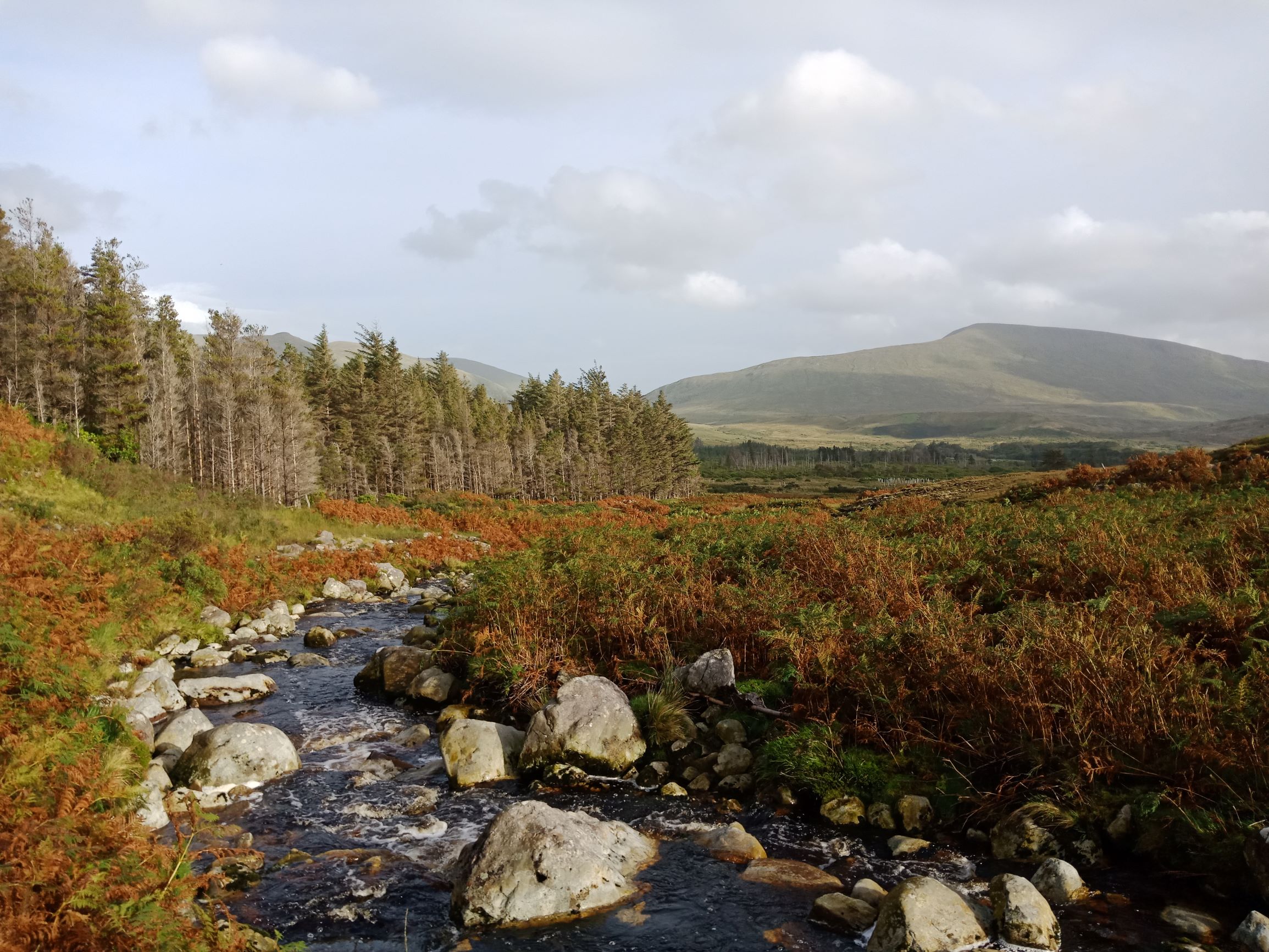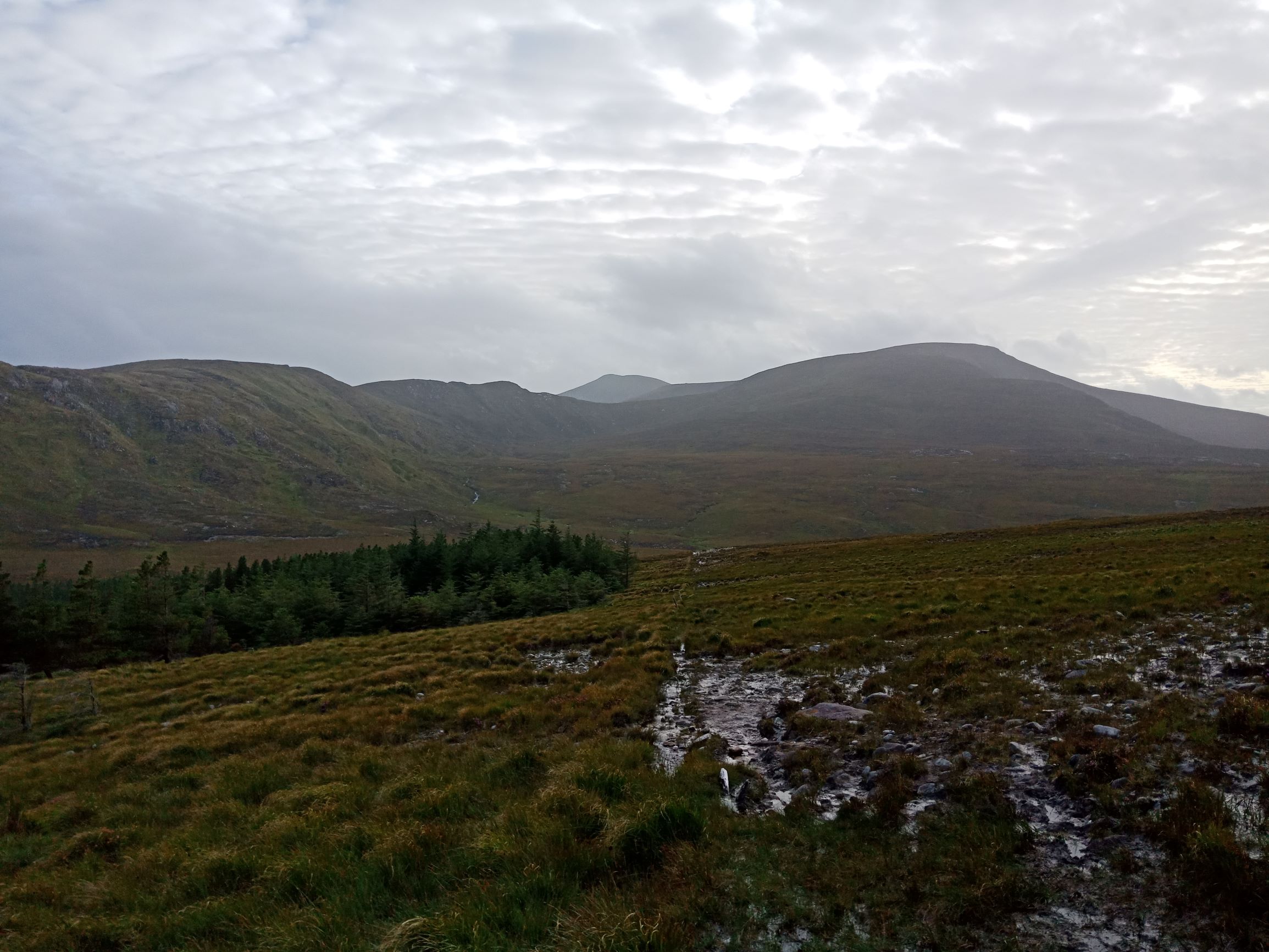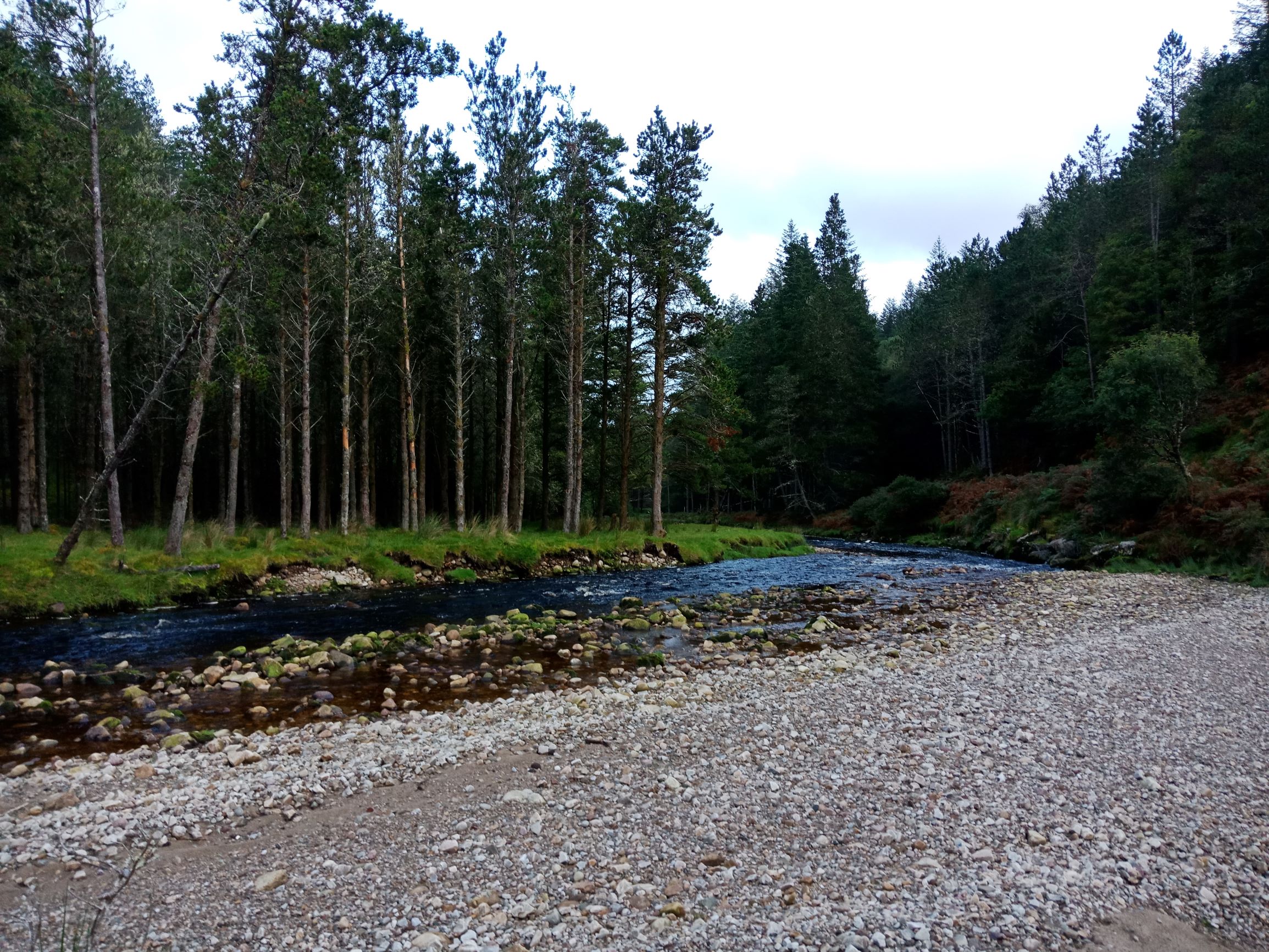
I feel like I’m doing something illegal as I approach the summit of the loop. I’m in the most remote part of the country, standing on a height after stomping through waterlogged bogs, leaping from rock to rock to navigate trickling fledgling limestone riverbeds, and hopping over small streams with great big standing jumps, getting further and further from civilisation with each step.
There is nobody and nothing around me for miles. In this day and age it feels somewhat like an act of rebellion to venture off into the countryside alone for a couple of hours, and I’ve a vague if illogical feeling that I’m doing something I shouldn’t just by the sheer distance I’ve put between myself and civilisation, like I’m packing it all in and going to go and live in the woods (or on the side of a mountain bog at least), if only for a couple of hours.
This is my first time here, and my assumption was that the marked Letterkeen Loop would be comparable to other national park areas like Diamond Hill in Connemara National Park, which has an impressive level of workmanship that maximises comfort and safety while minimising disruption to the land. “They’ve done a great job on it” is the phrase that gets thrown about.
I’ve only hiked it as a social excursion, but have cast sideways glances at the odd runner taking the course at a rapid pace with careful steps and thinking I’d give it a go. But wanting to give a bit of the business to my own county, and always on the lookout for new places to visit I said I’d check out the one a bit closer to home. I quickly found out that this would be an altogether different type of challenge – and one that would require a bit more thought, care, and a more thoughtful pace – than I was expecting.
Here, in contrast to Diamond Hill’s boardwalks and carefully wedged-in stones , there’s often little to distinguish the trail from the rest of the bog, the odd rock sometimes being the only means of navigating shallow streams. Very shortly after leaving the carpark I’d learn that the Nephin Beg Wilderness really does live up to its name and in that spirit its thankfully been left quite untouched.
The drive from Newport is stunning in itself – the drive to Newport not too bad either – though its equally deserving of the respect for the trail as it winds around the understated beauty of Lough Feeagh. Sheep have the right-of-way, and it’s a single-track road with little room for error, plenty of blind corners and hills, and distracting views. When I get to the trail head there are only a couple of cars, machinery tidying up the last hour of the work week, seemingly engaged in extending the modest car park.

I start eagerly, crossing the bridge and jogging to the end of the boardwalk before I get lost, immediately. Following a light trail into the woods leads me to a dead end of brambles. I try to find a passage through the trees, but the trail goes nowhere. Eventually I realise the boardwalk is a false dead-end and I’ve to go out beyond it along the river.
Soon enough it becomes apparent that this is a different type of trail to what I was expecting, and it’s not for running. Not at this time of year anyway, though it has the feel of an area that’s always a bit damp. There is little in the way of a trail, and what is there is lightly waterlogged – just enough to put you off running through it – and often steep. The trail disappears and continues as a series of rocks, or steps carved out through the sod, but not by shovel or hand.
The trail rises steadily and the terrain changes, steel bridges aid crossings over the widest and deepest of rivers. Some of the streams feature little stone steps, though their placement feels either accidental and the result of years of natural wear and tear, or as though a recent hiker left them there as an act of pity for the next poor creature who’d have to navigate the shallow streams with saturated socks and sodden spirits.
This place is wild.
This place is also wet, and though the pairing of those features isn’t as seductive as it might sound in a different context, there is an incredible romance in being drawn upwards, out of the populated world and into the heavens, though I’m perplexed that the higher I go the wetter the ground seems to get. Every surface is somewhat waterlogged and I have to watch my step, especially the final stretch of bog rising to the top of the highest peak on the loop.
About a third of the way into the trail, there’s a fork in the road. I was about to take the lower one (Red Route) which continued from the split along a tidy looking boardwalk (the last I would see on the trail) but had a change and swelling of the heart last minute and decided that while I’m here, I might as well do the full loop (Purple route) which is two kilometres longer at 12km, and takes you up to an elevation of 310m. At the split, there’s also a warning sign indicating that beyond it lies the Bangor Trail, a long established – and utterly bleak and remote – walking trail which sees an annual pilgrimage to complete a route that’s been dubbed “The Loneliest Place in Ireland.”
It’s just as well my pace is arrested by the terrain, as I don’t want to frighten the quite regal looking black mountain sheep that stand sentry on higher points of the hills as I traverse up and across towards the top. The trail is not as obvious at this point and I’m perplexed that the ground has gotten even wetter the higher I’ve climbed, though I am in pure bog now, a thick brown waterlogged mattress sitting on the limestone trail I was following earlier.
When I get to the summit there is little evidence of civilisation in any direction. Some houses in neighbouring valleys, several kilometres away. There are mountains, Lough Feeagh stretches back beyond towards Newport, almost coming to meet in a kiss at the narrow point where it rivers past Newport and into the sea.
I’m all alone.
I check my phone, which I’ve done myself the mercy of forgetting about, to scan the map and try to get a sense of where I am. I follow its compass and point myself in the direction of Newport, directly south, towards Castlebar, towards Crossmolina. I wonder if I’m near the other Nephin and see its familiar loaf peeking out beyond hills to the west. In every direction there are forests, both standing and felled, and empty, open land stretching for miles. And miles, and miles. Even if only for a few minutes and hours, I feel free.
Beauty is a mix of objective truth and subjective taste. Other places may be easier on the eyes, with more vivid colours and perfect contours, and lusher indicators of life and vitality, but sometimes the wildness of a harsh landscape stirs your heart in similar ways; the bleak and haunting image of a place without human life bringing to the fore your own stark human urges in ways you haven’t attended to for quite some time. All you can hear
I stand on the pile of stones on the summit, hoping I haven’t violated some kind of resting place for the dead which such a thing might signify in some cultures. How well I don’t know about my own, though I’m pretty sure that even in the parish of Burrishoole they don’t leave the remains of the dead on hillsides to be picked apart by vultures. I look for a stone to add to the pile in prayer but I can’t find a single one, they’ve all been placed in the pile already, and now the mountain top has no more loose stones left.

When I get back to the flat ground I jog along the service road to the car park, unable to resist getting my training fix in for my competitive pursuits back in the so-called real world. The river that runs along the road is one of the most beautiful sights I’ve ever seen in Ireland – objectively, subjectively, any which way I look at it.
I’m absolutely exhausted when I complete the loop back to the car park. I’ve been hiking, trotting, leaping, standing, stepping, clambering, jogging, and meditating for almost two hours. I am tired, and it feels different to the tiredness of a typical hike or run. There’s something more going on than just exercise when you put yourself in that state in these environments, of pushing yourself a little bit beyond a comfortable pace, a multiplying of forces with the natural world and the feelings of awe and wonder they inspire acting as the multipliers. Being in a place of utter solitude makes for the wonderful inspiration, though I’m eager to get back to the world of others as well. Far from the loneliest place in the country it feels like the most whole, the most complete.